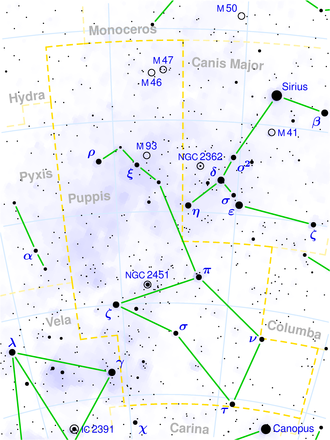NGC 2566
| Galaxy NGC 2566 |
|
|---|---|

|
|
| The center of NGC 2566 imaged in the infrared by the Hubble Space Telescope | |
| AladinLite | |
| Constellation | Aft deck of the ship |
|
Position equinox : J2000.0 , epoch : J2000.0 |
|
| Right ascension | 08 h 18 m 45.6 s |
| declination | -25 ° 29 ′ 58 ″ |
| Appearance | |
| Morphological type | (R ') SB (r) from |
| Brightness (visual) | 11.0 mag |
| Brightness (B-band) | 11.8 mag |
| Angular expansion | 2.9 ′ × 1.7 ′ |
| Position angle | 62 ° |
| Surface brightness | 12.6 mag / arcmin² |
| Physical data | |
| Redshift | 0.005460 ± 0.000010 |
| Radial velocity | 1637 ± 3 km / s |
|
Stroke distance v rad / H 0 |
(64 ± 5) · 10 6 ly (19.5 ± 1.4) Mpc |
| history | |
| discovery | Wilhelm Herschel |
| Discovery date | March 6, 1785 |
| Catalog names | |
| NGC 2566 • PGC 23303 • ESO 495-003 • MCG -04-20-008 • IRAS 08166-2520 • 2MASX J08184560-2529582 • SGC 081638-2520.4 • GC 1648 • H III 288 • HIPASS J0818-25 • LDCE 561 NED012 | |
NGC 2566 is a bar-spiral galaxy of the Hubble type SBab in the constellation Puppis in the southern sky . It is estimated to be 64 million light years away from the Milky Way and has a diameter of about 55,000 ly.
In the same area of the sky is the galaxy IC 2311 .
The object was discovered on March 6, 1785 by the astronomer Wilhelm Herschel with a 48 cm telescope.
Web links
Commons : NGC 2566 - collection of images, videos, and audio files
